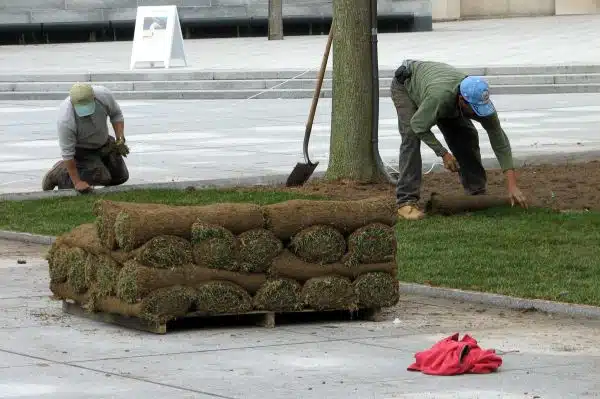Creating a lush, green lawn is the dream of many homeowners. One of the most effective ways to achieve this is by laying sod, which is essentially grass that has been grown on a layer of soil held together by roots or other materials. Laying sod can be a daunting task for those who are inexperienced, but with the right tools and knowledge, it can be done successfully.
As a landscaping and lawn care expert, I have seen firsthand the positive impact a healthy lawn can have on both the aesthetics and value of a property. However, laying sod requires careful planning and execution to ensure optimal growth and longevity. In this article, I will provide step-by-step instructions on how to lay sod properly to start a new lawn. Whether you are starting from scratch or replacing an existing lawn, these tips will help you create a beautiful and thriving green space that you can enjoy for years to come.
Preparing The Site For Sod Installation
According to recent studies, a well-maintained lawn can add up to 15% value to your home. This means that investing time and effort in preparing the site for sod installation can pay off in the long run. The first step is choosing the right location. Consider factors such as sunlight exposure, soil quality, and drainage before deciding on where to install your new lawn.
Once you have chosen the location, it’s time to prepare the soil. Start by removing any existing grass or weeds from the area. Use a rake or tiller to loosen the soil and remove any rocks or debris. Next, test the pH level of your soil using a soil testing kit. Most lawns prefer a pH level between 6 and 7. If your soil is too acidic or alkaline, you may need to add lime or sulfur to balance it out.
Properly preparing the site is crucial for ensuring that your new lawn takes root and thrives. Choosing the right location and preparing the soil are essential steps that should not be overlooked. In the next section, we will discuss how to measure and order the right amount of sod for your lawn installation project.
Measuring And Ordering The Right Amount Of Sod
Before laying sod, it is essential to calculate the amount of sod required to cover your lawn. To achieve this, you need to measure the length and width of your yard. Multiply these two numbers together to get the square footage of your lawn. Ensure that you add an additional 5-10% for any curves or odd shapes in your yard, as well as waste due to cutting around sidewalks, driveways, and other obstacles.
Once you have determined the appropriate square footage of sod needed for your lawn, it’s time to calculate the cost. The cost will vary depending on factors such as the type of sod you choose and where you purchase it from. It’s always advisable to obtain quotes from various suppliers before making a purchase, ensuring that you get a fair price. Also, consider purchasing more than what is required since having extra sod can be useful in case of damage or if other areas need patching.
Dealing with excess sod is important since leaving it lying around can cause pests or attract unwanted animals to the yard. If there are no further plans for use after measuring and ordering, it’s best to return it to the supplier for credit or donate it elsewhere. Alternatively, consider repurposing leftover sod pieces for garden paths or stepping stones by using a sharp spade or knife to cut them into smaller sections. By doing so, not only do you save money but also reduce waste and keep your lawn healthy.
Transition: Now that we’ve measured our lawn area correctly and ordered enough turfgrass let’s move on to selecting a type of grass that suits your climate conditions.
Choosing The Right Type Of Sod For Your Climate
Ah, the joys of lawn care. Nothing quite compares to the feeling of having a lush, green yard to enjoy during the warmer months. When it comes to laying sod for a new lawn, one of the most important factors to consider is choosing the right type of sod for your climate. After all, not all grasses are created equal.
If you live in an area that experiences hot and dry weather, then drought-tolerant options may be your best bet. These types of sod are designed to withstand long periods without water and can go dormant during times of extreme heat or drought. Some popular choices include Bermuda grass and Zoysia grass.
On the other hand, if you have areas of your property that receive ample shade throughout the day, then shade-tolerant options will be necessary. These types of sod are specifically designed to thrive in low-light conditions and can help prevent erosion on slopes or hillsides. Some popular choices include St. Augustine grass and fescue blends.
As you can see, choosing the right type of sod for your climate is crucial to ensuring a healthy and vibrant lawn. By selecting a variety that is well-suited to your specific region’s conditions, you’ll be able to save time and money on maintenance while enjoying a beautiful outdoor space all year round. Now that we’ve covered this essential step in laying sod for a new lawn let’s move on to discussing the tools needed for proper installation.
Tools Needed For Sod Installation
Proper installation of sod requires the use of certain tools to ensure that the job is done correctly. One key tool is a sod cutter, which is used to cut turf into manageable pieces for easy laying. There are two types of sod cutters: manual and motorized. Manual sod cutters require physical effort, while motorized ones operate using gasoline or electricity.
When installing sod, it’s important to wear protective gloves to avoid injury from sharp objects or irritants in the soil. The best gloves for sod installation are those made from durable materials like leather or synthetic materials with reinforced palms and fingers. These gloves provide ample protection against cuts and scratches while still allowing you to maneuver the turf pieces into place.
In summary, having the proper tools is essential when installing sod for a new lawn. A sod cutter makes it easier to handle large amounts of turf, and durable gloves help protect your hands during the process. When selecting gloves, opt for ones that have reinforced areas where your hands are most vulnerable. In the next section, we will discuss how to remove existing grass and weeds before laying down your new lawn.
Removing Existing Grass And Weeds
Just like a painter needs a clean canvas to create a masterpiece, laying sod requires a smooth and level surface. Before you start the actual installation process, it is essential to remove any existing grass or weeds from the area where you plan to lay your new lawn. This step ensures that your sod has direct contact with the soil, allowing roots to establish successfully.
There are two ways of removing existing grass and weeds: chemical alternatives or manual removal methods. Chemical alternatives consist of using herbicides that kill off unwanted vegetation. However, this method requires careful consideration as chemicals can harm other plants in the surrounding area if not used correctly. Manual removal methods involve physically digging out the grass and weeds with shovels or other tools. This method is more time-consuming but does not pose any risks to other plants’ health.
Once you have removed all unwanted vegetation, it’s time to prepare the soil by grading and leveling it. This step involves breaking up large clumps of dirt, smoothing out high spots, and filling in low areas with additional soil. A level surface is crucial for proper drainage and uniform growth of your new lawn. After completing this step, you’re ready to move on to the exciting part: installing your new sod!
Transition into subsequent section: With a smooth and level surface prepared, it’s time to lay down your brand-new sod!
Grading And Leveling The Soil
Grading and leveling the soil is an essential step in laying sod to start a new lawn. Before doing this, it is important to address the drainage of the area. The land should be graded in such a way that water flows away from any buildings or structures and towards lower-lying areas. This allows for proper drainage and prevents waterlogging which can lead to poor growth and even death of your newly laid sod.
Soil testing for pH levels is also crucial before grading and leveling the ground. A soil test will determine if any amendments need to be made to adjust the pH level of the soil, ensuring optimal growth conditions for your new lawn. A pH level between 6.0 and 7.0 is ideal for most grass types. If necessary, adding lime or sulfur can help balance out overly acidic or alkaline soils respectively.
Once you have addressed drainage issues and adjusted pH levels as needed, it’s time to grade and level the soil. Use a rake or shovel to remove any rocks, roots, or debris from the area before filling in any low spots with additional topsoil. Aim for a smooth surface with no high spots or depressions that may cause uneven growth patterns in your new lawn. In our next section, we will discuss how adding soil amendments and fertilizer can further enhance your lawn’s growth potential while promoting overall health and sustainability.
Adding Soil Amendments And Fertilizer
Soil amendments and fertilizers are crucial when laying sod to start a new lawn. Before you begin, it is important to conduct a soil test to determine the nutrients that your soil is lacking. This will help you choose the right type of fertilizer for your lawn. There are two types of fertilizers: organic and synthetic.
Organic fertilizers are made from natural materials such as compost, bone meal, and blood meal. They release nutrients slowly over time, which helps to promote healthy growth in your lawn. Synthetic fertilizers, on the other hand, are made from chemicals and provide quicker results. However, they can also harm beneficial organisms in the soil if not used properly.
Performing a soil test before applying any fertilizer will ensure that you are providing your lawn with the necessary nutrients while avoiding over-application of any one nutrient that can lead to problems such as runoff or nutrient leaching. The benefits of soil testing include improved plant growth, reduced input costs, and better environmental stewardship. Once you have applied the appropriate amount of fertilizer based on your soil test results, it’s time to move on to watering the soil before installation.
Transition: With soil amendments and fertilizer properly applied, it’s important to prepare the ground by watering it before installing sod. This ensures that the ground is moist and ready for sod installation without causing damage or drying out too quickly.
Watering The Soil Before Installation
After adding soil amendments and fertilizer, the next step to prepare for laying sod is to water the soil. Pre-watering is a crucial step in ensuring that your new lawn takes root properly. It provides several benefits that will make your lawn healthier and more resistant to drought conditions.
Firstly, pre-watering helps settle the soil and eliminates any air pockets that have formed during the grading process. This ensures that the roots will have an easier time penetrating the soil and establishing themselves. Secondly, pre-watering moistens the topsoil layer, making it easier for sod roots to absorb moisture once they are installed. Finally, watering before installation allows you to check if there are any low spots or areas where water pools on your site, which you can correct before laying sod.
However, it’s essential to avoid overwatering your soil, as this can create problems with drainage and lead to poor root development. To avoid overwatering before installation, follow these tips: Water only enough to moisten the top 6 inches of soil; use a moisture meter to determine when you’ve reached this depth. Don’t water so much that the soil becomes muddy or starts pooling on top of it. Lastly, don’t forget about drainage; ensure that any excess water can quickly drain away from your site.
Now that you’ve pre-watered the soil correctly and avoided overwatering before installation, it’s time to begin laying sod. Proper installation techniques are essential for optimal results in establishing a new healthy lawn.
Starting The Sod Installation
Before starting the sod installation, it is essential to have all the necessary tools at hand. The basic tools needed for this process include a sharp knife or sod cutter, a wheelbarrow, a rake, and a garden hose. It is also important to have enough topsoil to cover any low spots in the ground where water may collect. Having everything ready beforehand will make the process smoother and faster.
One of the best practices when installing sod is to prepare the soil correctly. This includes removing any debris or rocks from the site and leveling out any high spots in the ground. It is also recommended to add a layer of compost or fertilizer to ensure that your new lawn has all the nutrients it needs to grow healthy and strong. Proper preparation will help ensure that your lawn will thrive for years to come.
Once you have prepared your soil and gathered all necessary tools, you are ready to lay down your sod. In the next section, we will go over how to lay your sod in a brickwork pattern for optimal results. Remember, taking care during each step of this process will lead to a beautiful lawn that you can enjoy for years with proper maintenance.
Laying The Sod In A Brickwork Pattern
Accurately measuring the area is the first step in laying sod in a brickwork pattern, as it will determine the size of the sod pieces and the number of pieces needed.
After measuring the area, it is important to prepare the soil by loosening it and removing any weeds or debris.
The next step is to level the soil and create a firm base that will allow the sod to be laid properly and evenly.
Finally, the soil should be fertilized and moistened to ensure that the sod will take root and establish itself in the new lawn.
Measuring The Area
Accurately measuring the area of your lawn is crucial before laying sod to ensure that you have enough material and minimize waste. Measuring accuracy is essential for a great installation, so it’s crucial to get it right the first time around. As a landscaping and lawn care expert, I highly recommend taking the time to measure your lawn accurately.
To achieve measuring accuracy, you’ll need some tools for measuring. You can use a tape measure or a measuring wheel to determine the square footage of the area you want to sod. These tools are easy to use and readily available at most hardware stores. Additionally, using an online calculator can be helpful when calculating irregularly shaped areas.
Measuring accuracy is key in determining how much sod you need for your lawn project. A sloppy measurement can result in excess materials or not enough sod to cover the area adequately. By utilizing accurate measurements and appropriate tools, you can ensure that your new lawn will be beautiful and healthy for years to come.
Preparing The Soil
Once you have accurately measured your lawn area, it’s time to prepare the soil before laying the sod. Preparing the soil is crucial for ensuring that your new lawn thrives and remains healthy for years to come. As a landscaping and lawn care expert, I highly recommend performing a soil test before laying the sod.
Soil testing can help determine the pH level of your soil and identify any nutrient deficiencies that need to be addressed. This information will guide you in selecting the appropriate fertilizer and amending materials to balance the pH level and provide necessary nutrients. Additionally, it’s essential to ensure proper soil drainage by leveling any uneven areas and removing debris or rocks that can impede water flow.
Once you have addressed any issues identified by the soil test, it’s time to till the soil thoroughly. The goal is to break up compacted soil and create a loose, aerated surface for optimal root growth. You may also want to consider adding organic matter such as compost or peat moss to improve soil structure further. By adequately preparing your soil before laying sod in a brickwork pattern, you’re setting your new lawn up for long-term success.
Trimming The Edges And Corners
Did you know that a well-maintained lawn can increase the value of your property by up to 15%? Trimming the edges and corners is just as important as laying sod when it comes to creating a beautiful and healthy lawn. Neglecting this step can lead to uneven growth, which can cause a variety of issues down the line.
To make sure your lawn looks its best, be sure to have the proper equipment on hand. A sturdy pair of garden shears or an electric trimmer are both great options for trimming grass around edges and corners. Additionally, investing in a good edger can help create clean lines along sidewalks and driveways.
When it comes to trimming techniques, there are a few things to keep in mind. First, always make sure your blades are sharp. Dull blades can damage grass and leave ragged edges that are prone to disease. Second, take care not to cut too much at once. This can weaken the grass and leave brown patches behind. Finally, don’t forget about hard-to-reach areas like around trees or along fences – these spots require extra attention to ensure even growth.
Now that you’ve trimmed the edges and corners of your new lawn, it’s time to focus on watering it properly after installation. Remember: proper watering is key to establishing healthy roots and ensuring long-term success for your new lawn!
Watering The Sod After Installation
- Watering frequency for newly laid sod should be determined based on temperature, soil moisture levels, and local climate conditions.
- Generally, newly laid sod requires about 1 inch of water per week, delivered via a sprinkler or irrigation system.
- It is important to water deeply and infrequently, as opposed to light, frequent watering, as this encourages the roots to grow down rather than up.
- For the first two weeks, water the sod in the early morning hours, as this helps prevent evaporation and water loss.
- After the initial two weeks, water the sod in the late afternoon or early evening, and reduce the frequency as the root system develops.
- To prevent erosion, a light layer of straw or wood chips should be placed over the sod to help keep the soil in place.
Watering Frequency
Achieving a healthy lawn requires proper watering techniques. One of the crucial steps in sod installation is to establish the right watering frequency. While it may seem easy, adjusting watering frequency can be challenging, especially for beginners. Nonetheless, it is essential to understand the signs of over or under-watering to avoid damaging your new lawn.
Overwatering can lead to root rot and other fungal diseases that weaken the sod’s structure. On the other hand, underwatering can cause wilting and discoloration of the blades due to dehydration. As such, it is necessary to monitor your lawn frequently to identify any changes that may indicate over or under-watering. Adjusting watering frequency will depend on factors such as climate, soil type, and grass species.
When starting a new lawn from sod installation, it is crucial to water frequently for the first few weeks until the roots establish themselves in the soil. Afterward, you can reduce watering frequency gradually while monitoring your lawn’s condition regularly. Generally, deep and infrequent watering is recommended for established lawns to encourage deeper root growth and greater drought tolerance. By following these tips and monitoring your lawn’s condition closely, you will achieve a lush green yard that enhances your home’s curb appeal without wasting water unnecessarily.
Watering Amount
Watering the sod after installation is a critical step in establishing a healthy lawn. One of the key factors to consider is the amount of water needed to keep the sod moist without over or under-watering it. Determining the correct watering amount can be tricky, but it is essential to achieve optimal growth and reduce water waste.
To determine watering amount, you need to consider various factors such as soil type, grass species, temperature, and humidity levels. Sandy soils tend to dry out faster than clay soils; thus, they require more frequent watering. Warm-season grasses like Bermuda and zoysia need less water than cool-season grasses like fescue and Kentucky bluegrass. Moreover, during hot and dry weather conditions, you may need to increase your watering frequency to prevent dehydration of the blades.
Tips for adjusting watering frequency include monitoring your lawn’s condition regularly and understanding its water needs. Watering too much or too little can cause damage to your newly installed sod. For instance, overwatering can lead to root rot while underwatering can cause wilting and discoloration of the blades due to dehydration. Thus, it is crucial to strike a balance that provides enough moisture for optimal growth without oversaturating the soil.
In conclusion, determining watering amount is crucial in achieving a healthy lawn after installing new sod. By considering various factors such as soil type, grass species, temperature, and humidity levels, you can adjust your watering frequency appropriately while monitoring your lawn’s condition regularly. By doing so, you will avoid under or overwatering your lawn while conserving water resources effectively.
Preventing Erosion
After establishing the importance of proper watering for newly installed sod, another crucial aspect to consider is preventing erosion. Soil stabilization and erosion control techniques play a vital role in maintaining healthy lawns while preserving the surrounding environment.
When water runs off your lawn during heavy rains, it can cause soil erosion and nutrient loss. One way to prevent erosion is by installing retaining walls or terracing your yard. These methods will help keep the soil in place while providing an attractive landscaping feature. Additionally, planting groundcovers such as clover or creeping phlox can help prevent erosion by holding the soil in place with their root systems.
Another effective technique for preventing erosion is by installing permeable pavers or gravel paths around your lawn. These materials allow rainwater to seep into the ground instead of flowing over it, reducing runoff and preventing soil displacement. Furthermore, adding mulch or compost layers around plants can help retain moisture while protecting against erosion caused by wind and rain.
Preventing erosion through various soil stabilization and erosion control techniques is essential for maintaining a healthy lawn and preserving our environment. By incorporating these methods into your landscaping plan, you can enjoy a beautiful lawn without causing harm to surrounding ecosystems.
Maintaining The Sod For Optimal Growth
After laying the sod, it is crucial to maintain it properly to ensure optimal growth. One of the most critical factors in maintaining a new lawn is watering frequency. It is essential to water the sod frequently for the first few weeks after installation to keep it moist and promote root growth. After the roots have established, reduce watering frequency but increase the amount of water applied each time.
Another important aspect of maintaining your sod is mowing height. The ideal mowing height for most grass varieties is between 2-3 inches. Maintaining this height promotes healthy root growth and helps prevent weed growth by shading out potential weeds. Be sure to regularly sharpen your mower blades to avoid damaging or tearing the grass blades.
It’s crucial to remember that proper maintenance goes beyond watering and mowing height. Fertilizing, aerating, and controlling pests are all crucial aspects of keeping your lawn healthy and green. In the next section, we will cover common issues that can arise when trying to maintain a new lawn and how to troubleshoot them effectively.
Troubleshooting Common Issues
As you begin to enjoy your new lush lawn, it is important to keep an eye out for common issues that may arise. Dealing with pests is a common problem that can ruin the beauty and health of your lawn. Insects such as grubs, chinch bugs, and sod webworms can cause significant damage to your grass by feeding on the roots or leaves. To prevent this issue, it is important to regularly inspect your lawn for signs of infestation and use appropriate pesticides if necessary.
Another issue that homeowners often face when maintaining their lawns is managing shade. If your lawn has areas that are heavily shaded, it may be difficult for grass to grow properly. This can create patches in your yard where the grass is thin or non-existent. To combat this issue, consider planting shade-tolerant species of grass or using alternative ground covers such as mulch or gravel in these areas. Additionally, pruning back trees or other vegetation that may be causing excessive shade can help improve grass growth.
In order to maintain a healthy lawn long-term, it is important to stay vigilant against these common issues and take proactive measures to prevent them from occurring. By dealing with pests promptly and taking steps to manage shade, you can ensure that your new lawn stays looking beautiful for years to come.
Enjoying Your New Lush Lawn
After successfully laying sod, the next step is to ensure that your new lawn thrives. One of the most crucial aspects of a healthy lawn is regular maintenance. Watering and fertilizing are essential, but it’s also important to mow your lawn regularly and to keep an eye out for pests and diseases. Make sure to research the specific needs of your grass type and climate to create a customized maintenance plan.
In addition to proper maintenance, consider decorating your new lawn with outdoor furniture. This can be an excellent way to enjoy your new space while also adding value to your home. Choose furniture that complements the style of your home and the landscape design, whether that be modern or traditional. Additionally, make sure to select materials that can withstand outdoor weather conditions.
Ultimately, maintaining a healthy lawn requires dedication and patience. Keep up with regular maintenance tasks such as watering and mowing, and don’t hesitate to seek help if you notice any issues with pests or disease. By following these tips for lawn care, you’ll be able to enjoy a lush green space for years to come!
Conclusion
A beautiful lawn is like a canvas that can transform the entire look of your house. Laying sod is an efficient and quick way to start a new lawn, but it requires proper planning and execution. Before installing sod, prepare the site by measuring and ordering the right amount of sod, choosing the appropriate type of grass for your climate, and removing existing grass and weeds.
Once you have installed the sod, ensure that you water it adequately to promote healthy growth and maintain it regularly. Troubleshoot any common issues such as pests or diseases that may affect your lawn’s health. With consistent care and attention, your new lush lawn will be a source of pride for years to come.
As a landscaping expert, I highly recommend investing time in preparing the site before laying sod. Just as an artist prepares their canvas before painting a masterpiece, preparing the soil is crucial for optimal results. Choose quality tools to reduce manual labor and ensure efficiency during installation. Remember that maintaining your lawn is essential to keep it looking vibrant and healthy. So sit back, relax, and enjoy the beauty of your new green oasis!
Image Credits
- “Sod laying” by Ragesoss (featured)





























